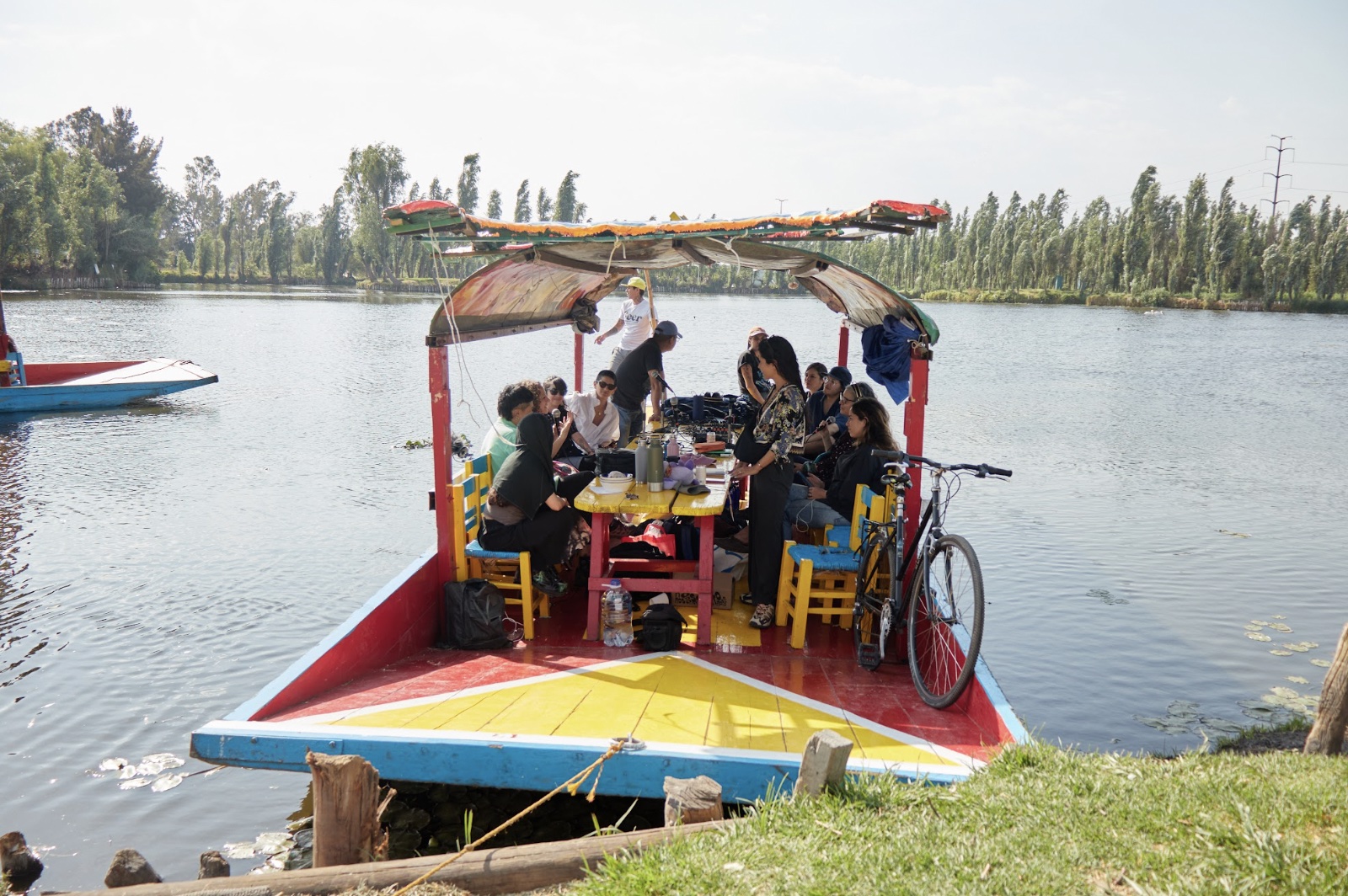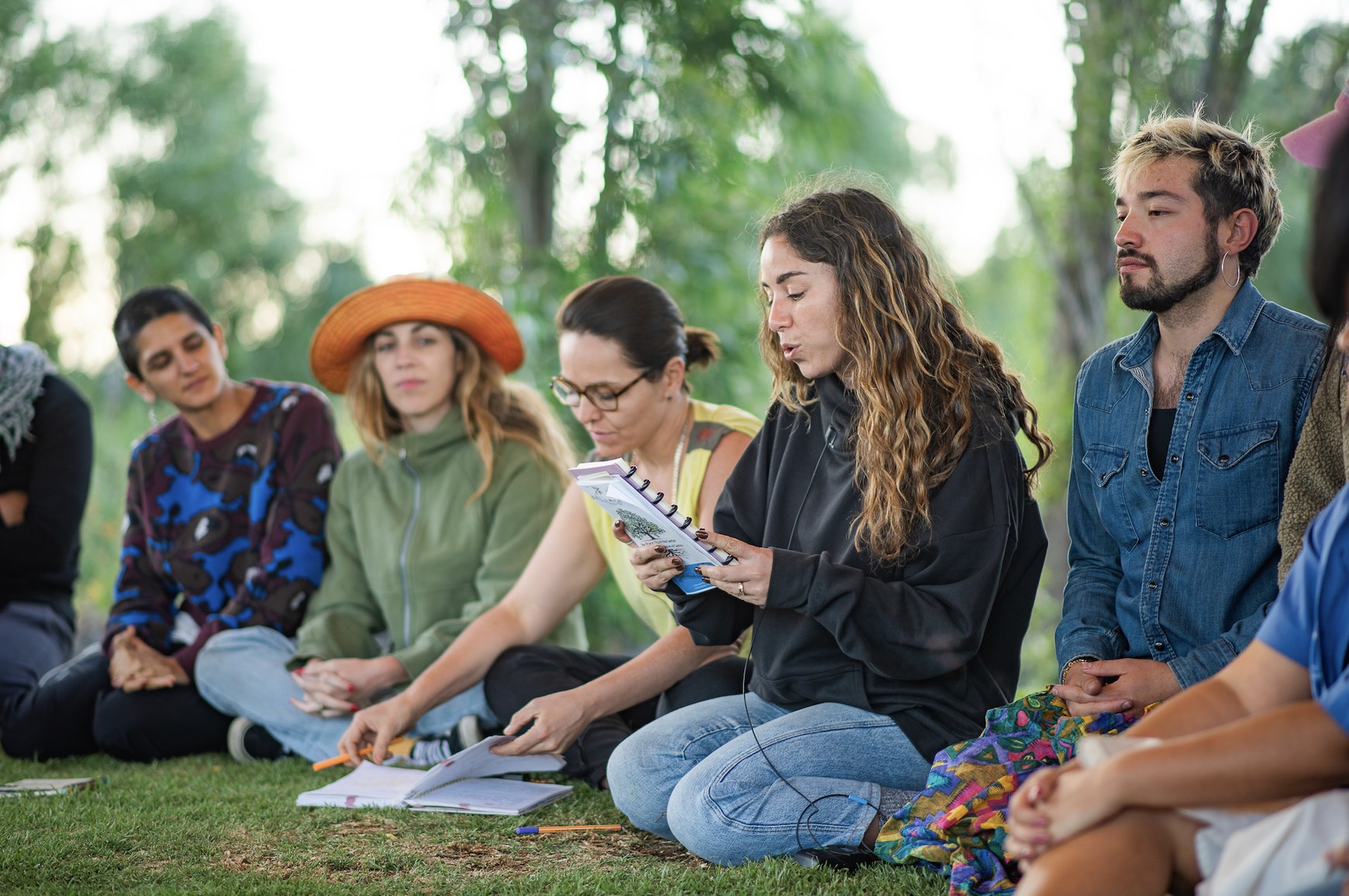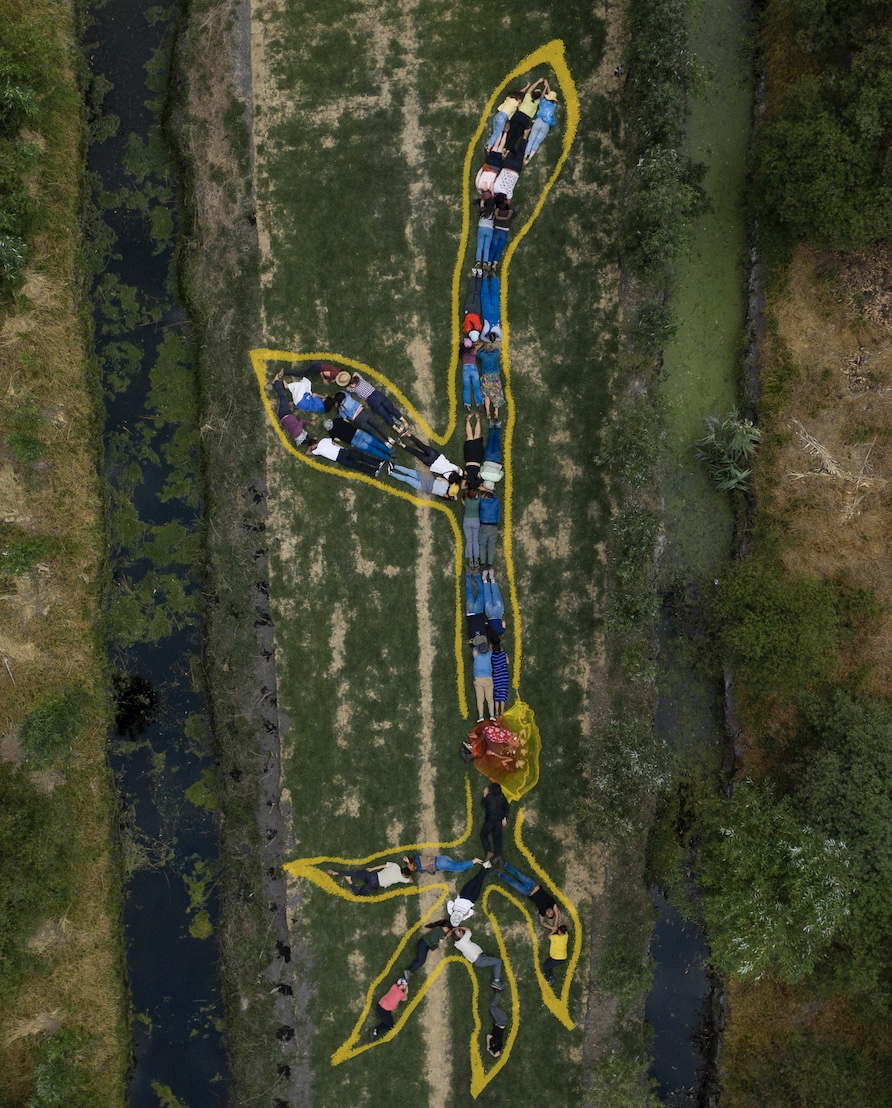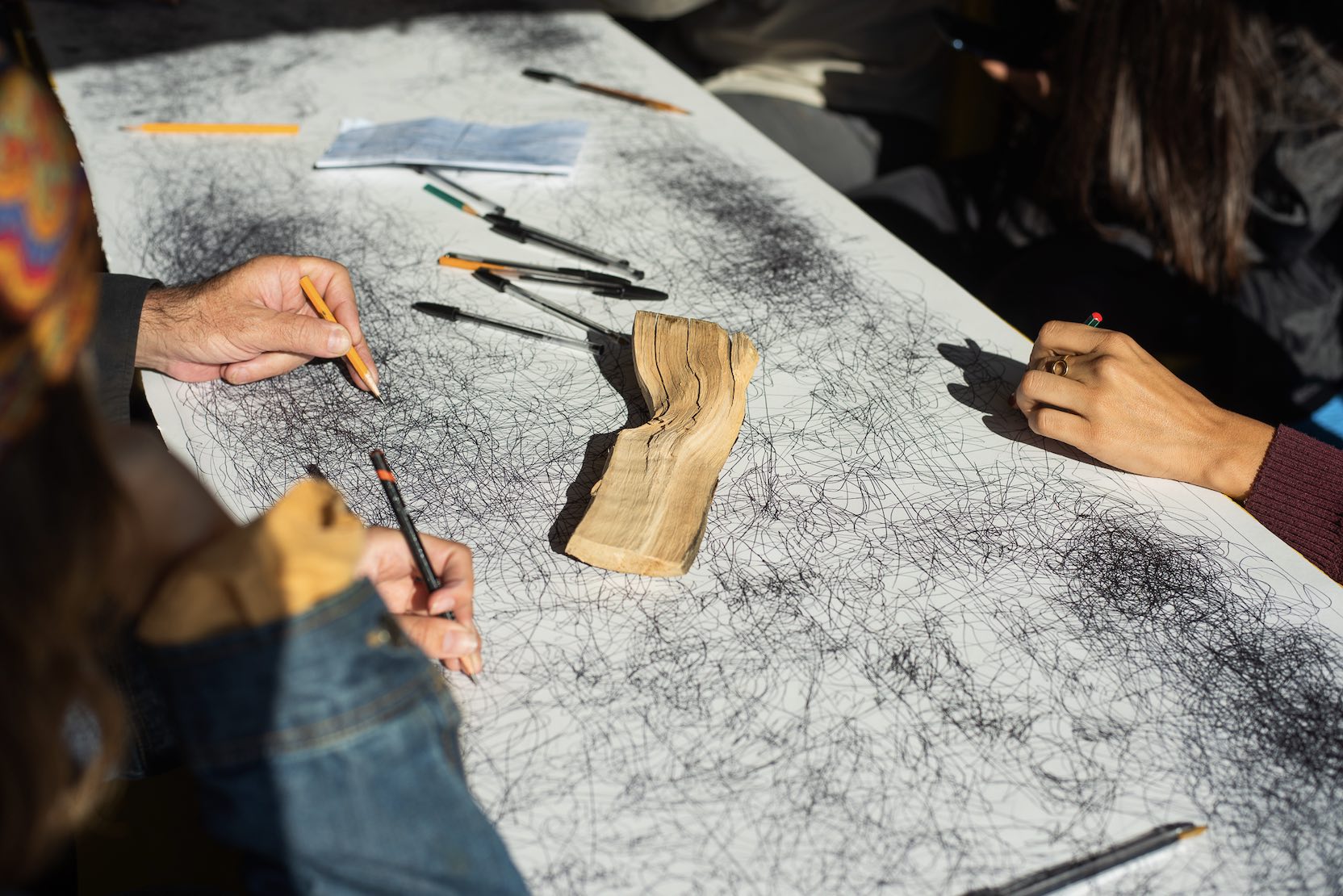
Interview
A Struggle for Life: Interview with Carolina Caycedo and Sofía Bastidas Vivar (Ruta del Castor)
by Sofía Ortiz
Reading time
8 min
How can we not just talk about a territory, but talk from a territory? How can we synthesize a conversation about a place characterized by canals, chinampas¹ , trajineras², tourists, birds, plastics, agriculture, injustices, fog, history, artists, community, and tradition? How do we learn about a place that is fundamentally fluid and ever-changing?
How do we listen to what is already there without imposing our needs?
"Sembrando Humedad" was a collaboration between Ruta del Castor (RDC), an association that connects artists with spaces for social practice, and Carolina Caycedo, a multidisciplinary artist who sought to answer these questions. It was—is?—an expansive and complex project. Even after a Zoom call with Carolina and Sofía (representing RDC), I can't fully grasp the extent of what it was. I review the facts that are clear to me. I know that RDC approached Carolina and that for two years they exchanged ideas, shaping each other's possibilities and desires. I know that in their press release they describe the project as "an encounter to collectively reflect on the relationship we have with water as a body that interweaves cultures and ecosystems." I know that the encounter took place in April over five days and included events such as screenings at the Tamayo Museum, a performative dinner at the Cárcamo de Dolores, activities at the Humedalia chinampa, and a radio broadcast in collaboration with Radio Nopal from a trajinera called Conchita. I know they invited collectives, artists, and institutions, including UAM Xochimilco, artists Alejandra Venegas and Ramiro Chaves, Seres de Río (from Colombia), The Hildegard von Bingen Society (from the UK), the Tecnológico de Monterrey, Cocina Colaboratorio, and Colectivo Almácigo, among others. I know they rested on the grass, ate from the milpa³, and marveled at how we can talk about water while being bodies of water ourselves. The body was present in many other ways, from hunger to emotion and tears.

Carolina Caycedo: The project was alive before we arrived. It is still alive thanks to the relationships that were formed from this encounter. As an artist, I always wonder in what ways a project can accommodate other voices, ideas, and pluriverses that can challenge the conventions of the exhibition space. The exhibition space can be a very dead place; it is not enough for me. How do we generate vitality in art-making?
Of course! If, as artists, we accept the barren convention of the white cube—whether as a starting point or a final destination—we end up with the commonplace: the bond sheets printed with room texts, the sponsorship of Don Julio 70, a cramped place to smoke. If, on the other hand, we work from complex spaces, crossed by multiple wills and without expecting a specific result...
Sofía Bastidas Vivar: The project became something much bigger than what we had planned.
CC: It took two years of conversation to understand how to frame it and weave it with other projects that already existed. What was "Sembrando Humedad"? It was not a symposium or a series of screenings, but rather a series of rituals, a sharing of knowledge that escapes the productivist ideas of contemporary art.
SBV: It was a process in which one part formed and informed the other.
CC: We put together a very long list of possible participants, which we edited carefully, taking into account the dynamics and politics of the place. It was very important for us not to fall into a visual exploitation of Xochimilco. We asked ourselves, what does it mean to bring in all these people from outside? We didn't want to be the helicopter art group that arrives and leaves. Ruta and I aligned ourselves in an interest to nurture existing networks and add lines of action to already flowing relationships.
SBV: It's the idea of not imposing needs but listening to what is already there.

One of the activities was a radio transmission from a trajinera that traveled through the canals of Xochimilco: interviews, dialogues, and sound recordings of various actions. I think of the movement of the trajinera, and I get the image of a cell emitting information in the bloodstream.
SBV: Radio was a way to listen to ourselves and reach people who were not with us. A way of hearing the territory, more than seeing it; of giving priority to listening, rather than to the visual.
CC: It had a dual purpose. On one hand, it is a way of making the intimate public. Recording from a trajinera is actually a very intimate experience, although at the same time, you are transmitting the trees, the birds, or someone standing on the shore of the lake. On the other hand, transmission makes archiving possible: we can rebroadcast the recordings and thus follow up on the conversation. The radio is an aesthetic conversation with the territory, a way to connect with that place that sustained us for three days.

In the cosmovision of different cultures, there is something that holds the universe. For the Mayas, a ceiba tree; for the Nordics, an ash tree. The Hindus speak of turtles, the Chinese too, and the Greeks of a punished Atlas. The most immediate function of the substrate is to sustain. If we can become aware of what is under our feet, we can then think about our feet themselves, our body, and perhaps, by extension, what is around us. To begin to turn our imaginaries towards radical interconnectedness, to collectivize knowledge and to survive in a world marked by injustice, pollution, and indifference. I ask Carolina and Sofía—I ask for their help, actually—how to deal with demoralization while working with these issues and from vulnerable places?
CC: There is something that the Zapatista teachers have taught us, and that is dignified rage. Arriving in Xochimilco, you feel that, an attitude that we are not going to leave. That dignified rage is very much accompanied by a feeling of hope; I don't get demoralized, I push myself. It demoralizes me much more to go to an exhibition and get bored. Finding complicity with a collective like Ruta also gives me hope, since it operates in spaces that are not exclusive to the contemporary art world. On the other hand, my greatest inspiration comes from the people on the front line, who have it much worse than me but are still there. I am an artist, and I work from the visual and the aesthetic, especially from the aesthetic forms that emerge from activism. Those publications, radio programs, guerrilla films, posters, and direct actions have a tremendous aesthetic and political sophistication, worthy of being read and interpreted with the tools that contemporary art gives us. That is where I resonate the most, within contemporary art that emerges from the grassroots of social and environmental movements, that touches on the most urgent issues of our society.
SBV: I do get demoralized, but I get a lot of inspiration from the work of others, especially those who keep things light despite how difficult it is. Doing projects where you don't know what's going to happen, letting things run their course and letting them spill out.

It occurs to me that not having a goal is like the samurai's soft focus; because you're not looking at something fixedly, you can see everything. At one moment, Carolina pauses; she says something that has stuck with me since we spoke.
CC: Actually, there is a goal. It is to protect life. It's very broad, but it's the goal that should guide us all. We are in a fight for life. Let's put life at the center!
Translated to English by Luis Sokol
1: A chinampa is a type of ancient Mesoamerican agricultural system used in the Valley of Mexico. It involves creating small, rectangular areas of fertile arable land by piling up mud and decaying vegetation from the lake bottom to create artificial islands. These were used for intensive farming and are often referred to as "floating gardens."
2: A trajinera is a type of flat-bottomed boat traditionally used in the canals of Xochimilco in Mexico City. They are often brightly painted and decorated, used primarily for transporting goods and people, as well as for recreational purposes. Today, trajineras are popular for tourism, where visitors can take boat rides through the canals.
3: A milpa is a traditional Mesoamerican agricultural system that involves the cultivation of multiple crops on the same plot of land. The term milpa often refers to a crop-growing system that includes maize (corn), beans, and squash, which are grown together in a symbiotic relationship. This method helps maintain soil fertility and provides a balanced diet.
Published on August 4 2024